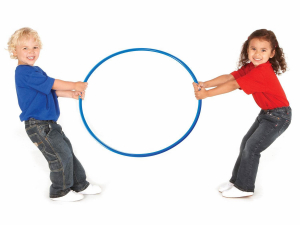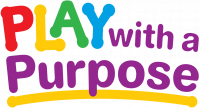It’s time to get reacquainted with the hula hoop! It is not just for hip swirling anymore. Instead, hoops are natural space markers. Hoops define a space that is big enough for kids to move around in, while still maintaining a safe distance from others. If I want to define a bigger space to allow for bigger movement, I will put two or three hoops together in a cluster, one cluster per child. For younger kids, I cluster hoops that are the same color for each child, so these visual learners have a cue for understanding their space. Susie stays in yellow, and Billy stays in green. For older kids, I cluster hoops of different colors, challenging them to think carefully about their bodies and how much space they are taking up.
Hoop clusters are great for games that involve throwing or kicking at a target. Kids start in their hoop, toss or kick a ball at the target, run to retrieve the ball, and return to their starting hoop. Simple and fun, but there is so much more a hoop can do!

How to Use Hula Hoops in Your Program
- Practice spatial and body awareness as well as patience by using hoops to create a queue. Have an activity where kids need to wait in line for a turn? Use hoops to designate their waiting space. When the first child in line starts the activity, everyone else moves up one hoop, leaving the last hoop available for the child who has just finished the activity.
- Practice body, spatial, and temporal awareness, as well as eye-foot coordination by using the hoop as a jump rope. With the hoop in front of the body perpendicular to the floor, place the hands on top, palms down and jump through the hoop. Flip the hoop up behind and then over the head to repeat.
- Practice the mechanics of throwing. Place the hoop beside the body on the favorite side, perpendicular to the floor. Place the favorite hand on top, palm down and flat, then push the hoop away while stepping forward with the opposite foot. Add in a little aerobic work and eye-hand coordination by chasing and catching the hoop before it falls to the ground.
- Practice body, spatial, and temporal awareness while strengthening the vestibular and proprioceptive systems, crossing the midline, building upper and lower body strength by using the hoop as a target for hand and foot placement. This game can be modified in lots of different ways. Try these:
- Put the hoop on the floor and ask children to stand in the hoop. Then, ask them to put one foot outside the hoop, while keeping the other foot inside and run around the hoop as fast as possible keeping one foot in and one foot out. Then switch feet and direction.
- Have them stand outside the hoop facing it and jump in and then out the other side. Turn around and repeat.
- Try jumping forward all the way over the hoop.
- Have them stand inside the hoop and jump sideways out of the hoop, sideways back in and sideways out.
- Have them put their feet inside the hoop and their hands outside the hoop so they are in a plank pose. Then, have them try walking all the way around the hoop keeping their feet in and their hands out.
- Have them put their hands in the hoop and their feet out, still in plank pose, and walk all the way around.
- Flip over and do the same thing as a crab walk.
Hoops are a terrific tool with so many uses. Keep in mind, hoops take a licking, so the more durable they are, the more they can withstand, and the less frequently you will have to replace them. For preschoolers, 24-inch hoops are the perfect size for small arms, legs and bodies, while younger elementary aged kids can go up to 30 inches
Hoops Games to Keep Kids Moving
Freeze and Melt, Ages 3-7
This game can be played outside or inside with hoops and lots of space, so kids get super aerobic while building some core, upper and lower body strength.
Equipment
- Hula Hoops. There should be a few more hoops than children.
- Upbeat Music (Move It from the Madagascar movie works well, but any upbeat song will work.)
Directions:
- Before the children arrive, lay the hoops in a circle spaced evenly and within your spacing protocols for your community or school.
- Ask the children to choose a hoop to stand in, 1 child per hoop.
- When the music starts, children will move around the circle stepping in the hoops.
- When the music stops, they are to go to the closest empty hoop and freeze like an ice cream cone, then melt all the way down until their belly buttons are on the ground.
- When the music starts again, they are to get up and start walking around the circle again.
Change Up:
- Vary how long the music plays and how long they stay on the ground. For older kids, make the transitions very quick, then alternate between quick and slow.
Hoop Movement, Ages 3-7
This is a great game to practice patience while waiting for a turn.
Equipment
- Hula Hoops, about 4-5 per child
Directions:
- Before the children arrive create a line of hoops for the children to stand in while they wait their turn, 1 per child
- With the remaining hoops, layer and stagger them one on top of another in a line about 2 feet wide. Make the gaps in the hoops just big enough for a child’s foot to fit.
- Explain to the children that the hoops are circles of fire and they must cross without touching a hoop with their foot, stepping carefully in the holes made by the overlapping hoops, to the other side.
Change Up:
- Children move through the hoops backwards or sideways.
- Children move through the hoops in a bear crawl or crab walk.
Hoop Carnival, Ages 4-9
This is a great game to practice eye-hand coordination.
Equipment
- 2 Hula Hoops per child
- 1 sturdy chair per child, or 1 per every 2-3 children
Directions
- Create a line of hoops, safely distanced, on one side of the play space. Parallel to that, line up the chairs, across from every hoop or every 2-3 hoops, approximately 4-6 feet away.
- Children will stand in one hoop and attempt to throw the other hoop over the back of the chair like a giant ring toss game. Older children can try throwing the hoops like a frisbee. Younger children, whose arms are not long enough to mimic a Frisbee throw, will throw more like a chest pass
Change up
- Each time a child is successful tossing the hoop over the chair back, have them move their hoop farther back from the chair.
Invest in some hula hoops and get those kids moving! Their bodies and brains will reward you with those big belly laughs we all love to hear.







Leave A Comment